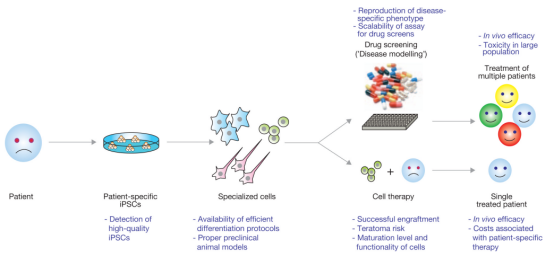Transcription factors (TFs) modulate various cellular processes and states through gene program regulation.
Overexpression of specific TFs has been demonstrated to regulate the differentiation of pluripotent stem cells into various cell types such as muscle and neurons. Takahashi and Yamanaka found that retroviral transduction of four genes (Oct4, Sox2, Klf4, and c-Myc) transferred somatic cells into a pluripotent state, albeit, through systematic studies of the roles of pluripotency-specific transcription factors in fibroblasts.
The Yamanaka factor-mediated initiation process stably programmed cancer cells such as leukemia, breast, bladder, liver, prostate, and pancreatic cancer cells into cancer stem cells (CSCs), with increased expressions of stemness-related genes including SOX2, NANOG, and others.
Based on these advances, researchers trends to develop disease models and drug screening strategies using induced pluripotent stem cell (iPSC) technology, which may enable autologous cell transplantation for clinical therapy in the future.

Fig. Introduction of reprogramming factors (Oct4, Sox2, Klf4, and c-Myc) into somatic cells gives rise to iPSCs.
Types of Transcription Factor (TF)
|
Abbreviation
|
Name
|
|
Oct4
|
Octamer transcription factor 4
|
|
Sox2
|
SRY-Box Transcription Factor 2
|
|
Klf4
|
Kruppel-like factor 4
|
|
Lin28
|
RNA-binding protein Lin28
|
|
Gata4
|
GATA binding protein 4
|
|
Hand2
|
Heart- and neural crest derivatives-expressed protein
|
|
Mef2c
|
Myocyte enhancer factor 2C
|
|
Tbx5
|
T-box transcription factor 5
|
|
Pdx1
|
Pancreatic duodenal hemeodomain protein-1
|
|
Ngn3
|
Neurogenin 3
|
|
Pax4
|
Paired box 4
|
|
NeuroD
|
Not applicable
|
|
c-Myc
|
Cellular-Myelocytomatosis
|
|
NANOG
|
Nanog homeobox
|
Yaohai Bio-Pharma Offers One-Stop CDMO Solution for Transcription factors
Reference:
[1] . Gong L, Yan Q, Zhang Y, Fang X, Liu B, Guan X. Cancer cell reprogramming: a promising therapy converting malignancy to benignity. Cancer Commun (Lond). 2019 Aug 29;39(1):48. doi: 10.1186/s40880-019-0393-5.

 EN
EN
 AR
AR
 HR
HR
 CS
CS
 DA
DA
 NL
NL
 FI
FI
 FR
FR
 DE
DE
 EL
EL
 IT
IT
 JA
JA
 KO
KO
 NO
NO
 PL
PL
 PT
PT
 RO
RO
 RU
RU
 ES
ES
 SV
SV
 IW
IW
 ID
ID
 LV
LV
 LT
LT
 SR
SR
 SK
SK
 SL
SL
 UK
UK
 VI
VI
 ET
ET
 HU
HU
 TH
TH
 TR
TR
 FA
FA
 AF
AF
 MS
MS
 BE
BE
 MK
MK
 UR
UR
 BN
BN


